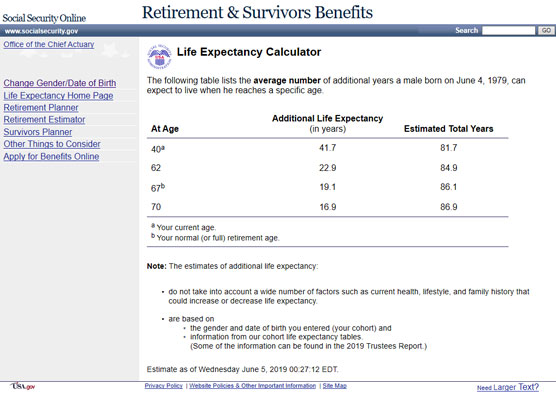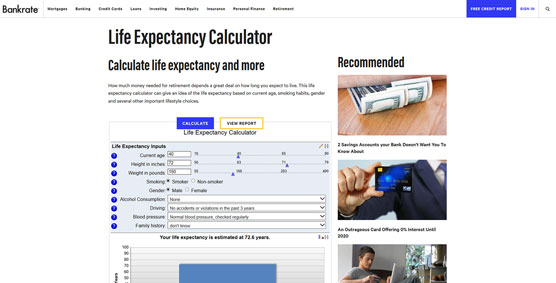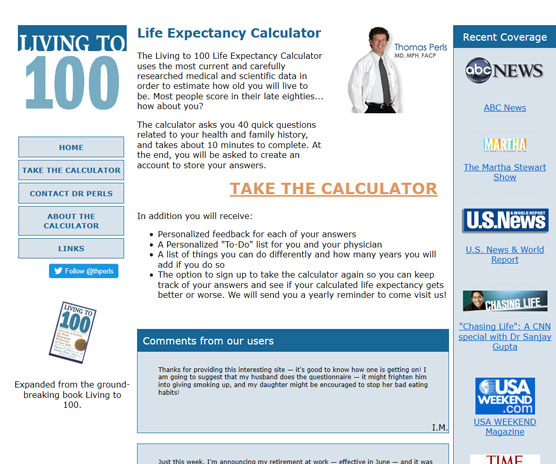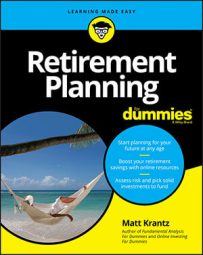| Year You Were Born | Life Expectancy (Both Sexes Combined) |
| 1955–1960 | 69.66 |
| 1960–1965 | 70.11 |
| 1965–1970 | 70.36 |
| 1970–1975 | 71.43 |
| 1975–1980 | 73.25 |
| 1980–1985 | 74.37 |
| 1985–1990 | 75.89 |
| 1990–1995 | 75.65 |
| 1995–2000 | 76.47 |
| 2000–2005 | 77.18 |
| 2005–2010 | 78.19 |
| 2010–2015 | 78.94 |
| 2015–2020 | 78.81 |
If you want to slice-and-dice life expectancy data to glean more precise insights about typical lifespans, you’re in luck. The United Nations’ World Population Prospect data query tool is a treasure trove of life expectancy data. You can see forecasts going out for decades, how females fare compared to men, and the changes to your life expectancy as you get older. Dig into this fascinating data.
Time to take a break from the history of retirement planning to answer the question you’re probably asking now that you’ve read this far: How long will you live? I am not getting fatalistic. Knowing how long you can expect to live is a big part of retirement planning. After all, a person who expects to live to 90 will save and work differently than someone likely to die younger.Social Security Administration’s Life Expectancy Calculator

The U.S. government has a good idea about how long you’ll live. After all, as the largest payer of income to older people, it’s in the government’s best interest to know this information.
The Social Security Administration’s Life Expectancy Calculator looks at your gender and date of birth to estimate how long you’ll live.
For example, if you’re a 40-year-old male in 2019, you would see a table like the one in the following figure after entering your gender and date of birth. You would be expected to live until 81.7, which means at 40 you’d be just about ready for a mid-life crisis. If you were healthy enough to make it to 67, the Social Security Administration would figure that you would make it to 86.
Bankrate’s Life Expectancy Calculator

You probably know that not all 40-year-olds will live exactly 81.7 years. Some lifestyle choices, such as smoking, have a bearing on how long you live. (Let’s forget about George Burns, the chain-smoking comedian who lived until 100.)
Bankrate tries to capture that variability in its Life Expectancy Calculator. You enter not just your age and gender but also personal details: height, weight, whether or not you smoke and drink alcohol, and a little family history.
Let’s go back to our 40-year-old male. He’s 6-feet tall, weighs 150 pounds, doesn’t touch alcohol, but does smoke. With that added detail, his life expectancy is now estimated to be 72.6 years, as shown here.
Life expectancy calculators provide estimates. Clearly, if you knew exactly how long you’d live, retirement planning would be a lot easier. Unpredictability is a key aspect that makes retirement planning — and life — an imprecise science.
Living to 100's Life Expectancy Calculator

Your life expectancy is an important input in your retirement plan. It’s worthwhile to revisit this factor periodically and carefully. The Living to 100’s Life Expectancy Calculator brings rigor to this process.
The calculator, shown in the following figure, asks a battery of questions covering everything from personal traits about your sleep patterns to lifestyle habits, nutrition, medical history, and family history. The calculator is free, but you need to set up an account with your email address.

